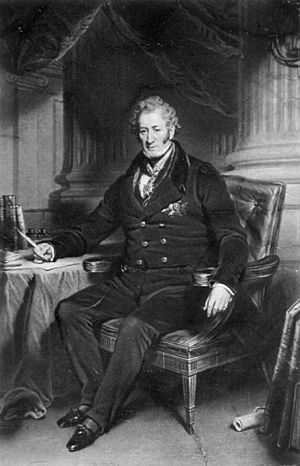William Burnett facts for kids
Sir William Burnett (born January 16, 1779 – died February 16, 1861) was an important British doctor. He became the chief doctor for the Royal Navy, which is the navy of the United Kingdom. He held special honors like Knight Commander of the Order of the Bath (KCB) and was a Fellow of the Royal Society (FRS).
Contents
William Burnett was born in a town called Montrose, Scotland, in 1779. He went to Montrose Grammar School. While he was studying to become a doctor in Edinburgh, he joined the navy. He started as a junior medical assistant on a ship called Edgar.
Later, he worked as an assistant doctor on the Goliath. This ship was led by a famous admiral, Sir John Jervis. William Burnett was part of several big naval battles. These included the Battle of St. Vincent and the siege of Cadiz. He also served bravely in the famous Battle of the Nile and the Battle of Trafalgar.
Caring for Prisoners and Patients
Between 1805 and 1810, Burnett was in charge of hospitals for prisoners of war. These hospitals were located in Portsmouth and Forton. He worked very hard and carefully in these difficult jobs. Because of his dedication, he was chosen in 1810 for a new role. He became the Physician and Inspector of Hospitals for the Mediterranean Fleet. This meant he was the main doctor overseeing medical care for the navy in that area.
His health became poor, so he returned to England in late 1813. However, in 1814, he was well enough to take on a new challenge. He became responsible for the medical care of the Russian fleet in the Medway. Many sailors in this fleet were very sick with a fever. At the same time, he also looked after prisoners of war in Chatham. A very strong fever was spreading among them too. After completing this important work, Burnett became a doctor in Chichester until 1822.
In 1822, Lord Melville offered him a position on the Victualling Board. This board was in charge of supplying the navy. Burnett worked with Dr. Weir, who was the Chief Medical Officer of the Navy at the time.
Later, William Burnett became the Physician-General of the Royal Navy. This role was later renamed Director-General of the Medical Department of the Navy. In this top position, he made many important changes.
- He asked naval doctors to regularly report on diseases they saw. This helped track health problems.
- He strongly pushed for and helped design the Melville Hospital at Chatham. This hospital was built especially for navy patients.
- He brought in kinder ways to treat naval patients with mental health issues at Haslar.
In 1841, the navy's medical team showed their great respect for him. They gave him a full-length painting of himself by Sir Martin Archer Shee. They also gave him a special set of plates. He played a big part in making sure assistant doctors in the navy had a better position and more respect.
Honors and Retirement
Burnett was chosen as a Fellow of the Royal Society in 1833. This is a very old and respected group for scientists. He was made a knight on May 25, 1831. This meant he could use "Sir" before his name. On April 13, 1835, he became the personal doctor to King William IV. Soon after, he received another honor, becoming a Knight Commander of the Royal Guelphic Order. In 1850, Queen Victoria gave him an even higher honor. She made him a Knight Commander of the Order of the Bath.
Burnett retired in 1855. Sir John Liddell took over his role as Director-General. After retiring, Burnett lived in Chichester, where he passed away on February 16, 1861. A place called Burnett Bay in Canada was named after him.
Burnettizing: A Special Process
In 1839, William Burnett received a special patent for something called Burnettizing. This was a way to protect ropes, canvas, and wood. It involved putting a water solution of zinc chloride onto these materials under pressure. This process helped them last longer and not rot.
The Admiralty, which managed the navy, found this method to be very good. However, Burnett tried to start his own business using this process. He wanted to supply treatments for wood used in building railways. This business venture ended up causing problems for his naval career.


